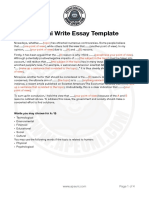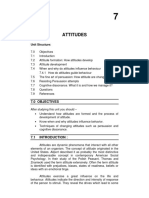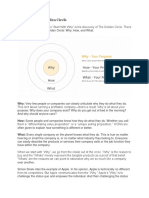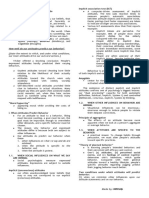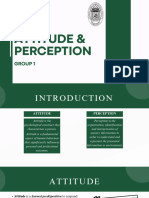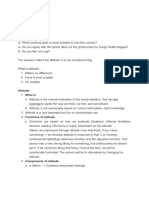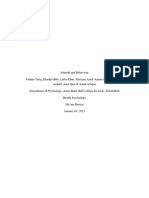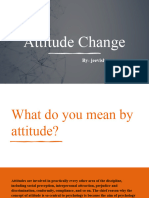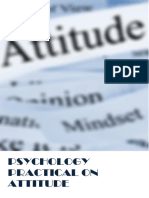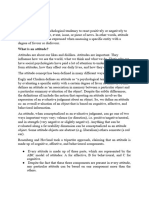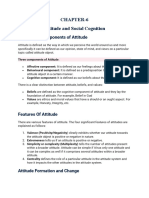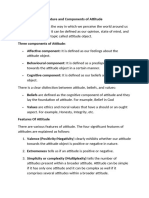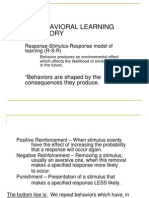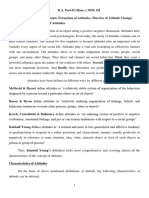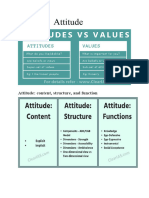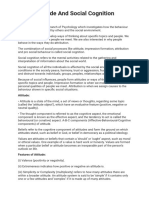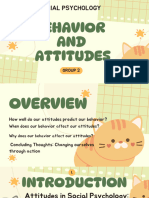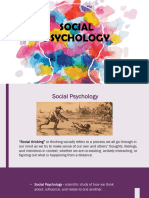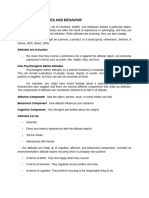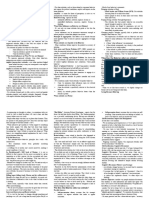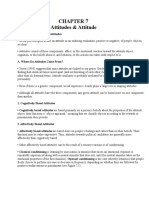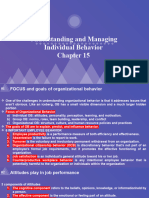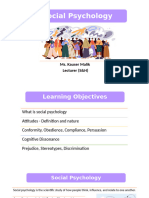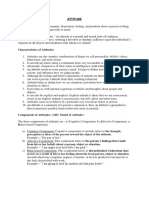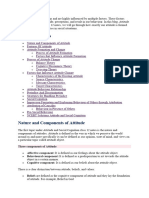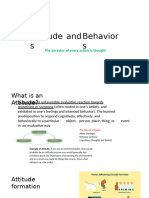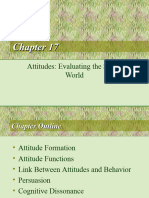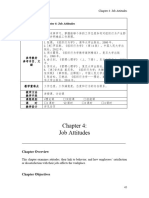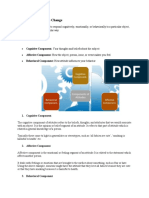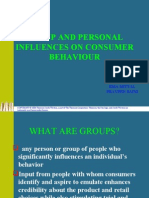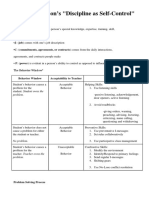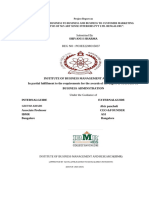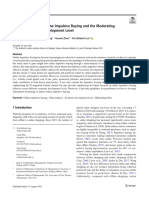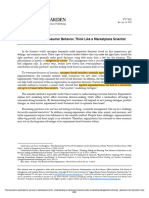Attitude Notes For Posting
Attitude Notes For Posting
Uploaded by
Steve Premier NaiveCopyright:
Available Formats
Attitude Notes For Posting
Attitude Notes For Posting
Uploaded by
Steve Premier NaiveOriginal Title
Copyright
Available Formats
Share this document
Did you find this document useful?
Is this content inappropriate?
Copyright:
Available Formats
Attitude Notes For Posting
Attitude Notes For Posting
Uploaded by
Steve Premier NaiveCopyright:
Available Formats
A brief run-through of Attitude (rough notes only)
I. The Nature of Attitude
A. > Definition – no precise definition but most psychologists concur that it consist of an
enduring evaluation (whether positive of negative) of people, objects and ideas.
> Not only feelings but also thoughts and tendencies to behave in particular ways towards
the object of attitude.
B. Three Components? Antecedents? Areas?
i. Cognitive – thoughts, beliefs towards the attitude object
ii. Affective – feelings/emotions towards the attitude object
iii. Behavioral – response tendencies towards the attitude object
generally, the 3 components are consistent with each other, but may not always be
consistent with each other.
Question to consider: which of the three tends to exert a more powerful effect?
II. The Formation of Attitude
A. Encountering the Attitude Object
i. Direct, some of our attitudes develop from actual experiences
ii. Indirect, through association (Classical Conditioning)
B. Parents and Peer Groups, great influence through:
i. reinforcement or operant conditioning, immediate reward
ii. social learning, through observation/imitation
C. Media Influence, can create attitude through info usually those info that affect an individual;
or can reinforce those that already exist
D. ABC Model of Attitude (Chaiken and Eagly, 1993), formation of attitude through affective,
cognitive or behavioral processes
III. Attitude and Behavior
A. What attitudes and what behavior? Can attitude predict behavior? There is a difficulty in
predicting behavior from attitudes. Why?
Level of specificity at which attitude and behavior are measured
Situational influences; don’t have another choice, that is, doing the behavior even when
attitude towards it is negative
Behavior is related to more that one attitude
* Theory of planned behavior (Martin Fishbein and Izek Ajzen, 1991; Fishbein & Ajzen, 1975)
- the best predictor of a person’s planned and deliberate behaviors are the person’s attitudes
toward specific behaviors and his/her subjective norms (his/her perceived expectations of
significant others)
- when people have time to contemplate how they are going to behave, the best predictor of
their behavior is their intention
Attitude towards
behavior
Behavior Behavior intention (is it effective?
(sipaon nako ako (para makabalos ko kay Ganahan ba ko manipa?)
igsoon) gikawat niya akong piso)
Subjective social norms
(ganahan si lalabs kung
manipa ko?)
* See Strangor (2015) for the 1991 illustration of the theory
If attitude does not easily predict behavior,
A. Then how do attitude influence behavior? How are attitudes, which are primarily internal,
be translated to behavior which can be observed? Process of how attitude influence
behavior:
1. if it is in our working memory – can be remembered at the moment (accessible memory)
2. over-all strength – attitudes formed from direct experience are stronger than #1
3. immediate events – like direct questioning, only when you’re asked of the attitude object
can you remember your attitude towards it; and/or sensory cues
4. behavior performance – something done which will have a direct implication to ones attitude
IV. Attitude Change, every attempt to change how we think, feel and behave hound us: from our parent,
family, friends, media, among others
A. Process of Attitude Change
i. The Stages of Attitude Change
1. Attention – not all messages we see are noticed; to cater to attitude change,
attention should be attained (get attention)
2. Comprehension – we may get the attention but do we understand? The message
may be too complex or ambiguous thus confusion may occur.
3. Acceptance – decision to accept communication depends on incentives that are
offered
ii. Elements of Persuasion, factors that determine whether we decide to change or not;
persuade – to cause someone to change his/her thinking and behavior
1. Source’s credibility, communicator may be more important than the message.
Components that can affect credibility:
a. Expertise, experts on a field are more credible
b. Trustworthiness, source is trustworthy if he talks against his interest; seen as
less bias
c. Physical Attractiveness, degree to which it can change attitude depends on the
media: with TV or print (visual media), it matters; with radio (audio) and written
words, doesn’t matter
d. Similarity, source’s ways which are relevant to the issue that recipient can relate
to.
2. Message, what is being communicated. 3 Factors that affect the message:
a. Content – are both sides of the argument presented? Should we scare people
(fear arousal)?
i. Magnitude of unpleasantness: relatively unpleasant message may cater to
attitude change than very unpleasant messages
ii. Probability that it would happen to you may cater to attitude change
iii. What people perceive dictates how unpleasant a message is
b. Organization – how organized is the message presented?
c. Medium – which media is used?
3. Context upon which persuading is done
4. Recipient
B. Theories of Attitude Change
Social Judgment Theory
o social judgment is an individual’s perception and judgment of a message
o considers attitude not as a single point but a range
o when the message is consistent with the thinking/feeling of the receiver, there is
latitude of acceptance; there is no attitude change
o when the message is in-between (being consistent AND discrepant), OR if
message is wrongly imparted (falling between the latitude of acceptance AND
rejection), there is latitude of non-commitment; there is attitude change
Balance Theory
o a balanced system is one in which you agree with a liked person or disagree with a
disliked person.
o Imbalance is uncomfortable and leads to pressures to change.
o People will change as few affective relations as they can and still produce a balance
system.
o Balanced pressures seen to be weaker when you dislike the other person than when
you like him/her. It appears that we simply do not care very much whether we agree
or disagree with someone we dislike; we just cut off the relationship and forget about
the whole thing.
Cognitive Dissonance Theory
- Dissonance is created when some behavior we have engaged in is inconsistent with
our attitudes. This dissonance creates psychological tension, and people feel
pressured to reduce or remove it.
- Attitudes will change in order to maintain consistency with overt behavior. Two
principal sources of attitude-behavior inconsistency are
the effects of making decision, and
the effects of engaging in behavior that goes against one’s attitudes.
- Postdecision dissonance: dissonance is reduced by increasing the attractiveness of the chosen
alternatives and/or decreasing the attractiveness of the unchosen alternative. The tendency toward
reevaluation is particularly strong when the two alternatives are initially close in attractiveness.
- Attitude-discrepant (or counterattitudinal behavior): When an individual holds a belief and performs
an act inconsistent with it, dissonance is produced. Since the behavior had already been done,
dissonance reduction takes the form of attitude change.
- The main preconditions for the arousal of cognitive dissonance and subsequent attitude change
are:
1. minimum incentives – enough to cause the behavior but not enough to justify it;
2. perceived choice – the absence of choice does not create dissonance;
3. irrevocable commitment – that is, feeling irreversibly committed to the course of action;
otherwise, no dissonance is aroused if the person feels he/she can get out of the decision
if it works badly;
4. foreseeable consequences/responsibility for consequences – if there is no way for the
person to have foreseen the negative outcome or if the person feels no responsibility for
the outcome, there is no dissonance regardless of how disastrous the result is;
5. great effort – the more effort one takes in doing a behavioral act that has negative
consequences, the more dissonance should be aroused
C. When attitudes don’t change, conditions when attitudes don’t change:
I. Anticipatory attitude change:
- attitudes can change even before a person receives a persuasive message: this is referred
to as anticipatory attitude change.
A. Elasticity (Cialdini, et al, 1973):
in response to various pressures, people moderate their position within a limited
range: however, when the outside pressure disappear, their attitudes snap back to
their original positions.
Attitude change in the laboratory reflects this
B. Anticipatory change as a form of Impression Management:
people moderate their original position in attempt to appear broad-minded to others.
Concerns with appearing moderate and reasonable happen only when people have
no personal investment in an issue.
II. Resistance to persuasion:
* forewarning about an attempt to persuade may lead some to anticipatory attitude
change but some evidence suggests that in the long run, forewarning encourages
resistance to the attempt
A. Inoculation (McGuire, 1964)
1. Experiment:
before hearing a persuasive message, subjects were presented with the following:
first group: arguments which supported group’s initial beliefs
second group: arguments that refuted the counterarguments that would be
used in the subsequent persuasion
third group: arguments that refuted counterarguments that would not be
used in the actual communication.
Findings:
First group: pax who heard arguments that supported their initial position
showed the least resistance to persuasion
Second group: pax who were exposed to weakened form of
counterarguments used in the attack showed the most resistance
Conclusions: exposure to a weakened form of a message can be effective in
producing defenses
2. Exposure to counterarguments INOCULATES a person against the subsequent
attack
B.Forewarning (even without the supplying counterarguments)
Petty and Cacioppo, 1977
when people are warned of a forthcoming message and are given time to think about
the issue, they consider their own positions and alternative positions, and they
generate cognitive defenses against the impending assault
You might also like
- Apeuni Write Essay Template: Words You May Choose For A / BDocument4 pagesApeuni Write Essay Template: Words You May Choose For A / BParag Chapre67% (3)
- AttitudesDocument9 pagesAttitudesshokor khanNo ratings yet
- Interpersonal Communications Chapter 4Document5 pagesInterpersonal Communications Chapter 4randomscribduser2012No ratings yet
- The Impact of Social Media in Our Daily LivesDocument2 pagesThe Impact of Social Media in Our Daily LivesSteve Premier NaiveNo ratings yet
- Chapter 3: The Golden Circle: Why: Very Few People or Companies Can Clearly Articulate Why They Do What They DoDocument4 pagesChapter 3: The Golden Circle: Why: Very Few People or Companies Can Clearly Articulate Why They Do What They DoJane RabiNo ratings yet
- CIPD Profession MapDocument28 pagesCIPD Profession MapPayal MagdaniNo ratings yet
- Attitude: Atmiya Institute of Technology and ScienceDocument4 pagesAttitude: Atmiya Institute of Technology and ScienceChirag SabhayaNo ratings yet
- CHAPTER 4-6psychDocument13 pagesCHAPTER 4-6psychChanGie Rhyl UbayNo ratings yet
- PCS - TYProduction - SEM V - 211040002 - Presentation On Interpersonal Skill - 2023Document13 pagesPCS - TYProduction - SEM V - 211040002 - Presentation On Interpersonal Skill - 2023virajsurana123No ratings yet
- 3) AttitudeDocument32 pages3) Attitudejai917146No ratings yet
- Paper 4Document25 pagesPaper 4Arushi AroraNo ratings yet
- SODHI's Attitude scale ReportDocument5 pagesSODHI's Attitude scale Reportpaulaaron0603No ratings yet
- Attitudes: "Evaluating and Responding To The Social World"Document27 pagesAttitudes: "Evaluating and Responding To The Social World"Rao UsamaNo ratings yet
- Health PsychologyDocument13 pagesHealth PsychologyKhadija KhanNo ratings yet
- 9.00 Exam 3 Notes: KOSSLYN CHAPTER 13 - Social Psychology: Meeting of The MindsDocument7 pages9.00 Exam 3 Notes: KOSSLYN CHAPTER 13 - Social Psychology: Meeting of The MindsSahil AnsariNo ratings yet
- Attitude and Social CognitionDocument6 pagesAttitude and Social Cognitions.santhoshNo ratings yet
- Psychology Project - AttitudeDocument6 pagesPsychology Project - Attitudexoranek474No ratings yet
- Attitude Change Social PsychologyDocument16 pagesAttitude Change Social PsychologyJaebeom's Best FriendNo ratings yet
- Psychology Project AttitudeDocument23 pagesPsychology Project AttitudeAgrima guptaNo ratings yet
- 6 ExplanationAttitude and Social CognitionDocument32 pages6 ExplanationAttitude and Social CognitionKAVITA PANDEYNo ratings yet
- D. Behavior and AttitudesDocument19 pagesD. Behavior and AttitudesMichael Angelo UyNo ratings yet
- AttitudesDocument43 pagesAttitudesRahul DhakerNo ratings yet
- AttitudeDocument5 pagesAttitudemaverickvivekNo ratings yet
- Attitudes and PerceptionDocument38 pagesAttitudes and PerceptionNitu RevankarNo ratings yet
- Psychology Notes Week 2Document9 pagesPsychology Notes Week 201234No ratings yet
- ATTITUDEDocument7 pagesATTITUDEnavyaduggal0408No ratings yet
- AttitudeDocument6 pagesAttitudemidjourney AINo ratings yet
- Chapter 6Document9 pagesChapter 6Ritu DahiyaNo ratings yet
- Sample Attitude PDFDocument55 pagesSample Attitude PDFRayonaNo ratings yet
- Movie Analysis GangubaiDocument20 pagesMovie Analysis GangubaitnimaNo ratings yet
- Nature and Components of AttitudeDocument11 pagesNature and Components of Attitudebestgamer9201No ratings yet
- Chapter 4 ReviewerDocument5 pagesChapter 4 ReviewerZari RiegoNo ratings yet
- Behavioral Learning Theory: Behaviors Are Shaped by The Consequences They ProduceDocument43 pagesBehavioral Learning Theory: Behaviors Are Shaped by The Consequences They Produceimadudin20076707No ratings yet
- Unit 2 AttitudesDocument19 pagesUnit 2 AttitudeskirtankdeepNo ratings yet
- Social Influence and CognitionDocument34 pagesSocial Influence and CognitionBrown GirlsNo ratings yet
- AttitudeDocument28 pagesAttitudejainmoulik33No ratings yet
- Psy 6Document8 pagesPsy 6Montfort.ala.officialNo ratings yet
- Inbound 5041873770226330538Document51 pagesInbound 5041873770226330538prettymaxine00No ratings yet
- Intro to Social-Psychology UpdatedDocument41 pagesIntro to Social-Psychology Updatedarsanshy.blueNo ratings yet
- 6. Attitude and Social CognitionDocument8 pages6. Attitude and Social CognitiondevinajhastudyNo ratings yet
- Attitude: DR Rajni SinghDocument16 pagesAttitude: DR Rajni SinghJanki DhankholaNo ratings yet
- OB Chapter TwoDocument16 pagesOB Chapter TwoSad BobNo ratings yet
- Theories in PsychologyDocument11 pagesTheories in PsychologyISMAIL MARERENo ratings yet
- Lesson 4 Social PsychologyDocument6 pagesLesson 4 Social PsychologyIvy Marie ToyonganNo ratings yet
- 2 Foundation of Individual Behavior and Learning in An OrganizationDocument47 pages2 Foundation of Individual Behavior and Learning in An OrganizationabelNo ratings yet
- SOCIAL PSYCH - Social Influence - Part 1 NotesDocument4 pagesSOCIAL PSYCH - Social Influence - Part 1 Notesdead persephoneNo ratings yet
- Chapter 6Document18 pagesChapter 6mertcakmak05No ratings yet
- Unraveling-the-Journey-from-Perception-to-ActionDocument10 pagesUnraveling-the-Journey-from-Perception-to-ActionJosarNo ratings yet
- 7 ChapterDocument7 pages7 ChaptermelchieNo ratings yet
- Chapter 15Document15 pagesChapter 15wulan.permatasariNo ratings yet
- Attitude Chapter (Revised New)Document8 pagesAttitude Chapter (Revised New)Essan BoriyaNo ratings yet
- Why Does Our Behavior Effect Our Attitude Lec#6Document10 pagesWhy Does Our Behavior Effect Our Attitude Lec#6bochick54No ratings yet
- Lecture 5 - Social PsychologyDocument34 pagesLecture 5 - Social Psychologyk233021No ratings yet
- ATTITUDEDocument3 pagesATTITUDEDipon GhoshNo ratings yet
- Chapter 6-Attitude (Batch 2020-21)Document38 pagesChapter 6-Attitude (Batch 2020-21)Sarita SainiNo ratings yet
- Attitude and Social CognitionDocument8 pagesAttitude and Social Cognitionlipsy bhattNo ratings yet
- Attitudes and BehaviorsDocument29 pagesAttitudes and Behaviorsumardauna.udNo ratings yet
- Psychology Atttitude and Other BehaviorsDocument8 pagesPsychology Atttitude and Other BehaviorsAaleen KttkNo ratings yet
- International Behavior.Document11 pagesInternational Behavior.Aaleen KttkNo ratings yet
- Attitude 4Document33 pagesAttitude 4elric4608No ratings yet
- Chapter 4: Job AttitudesDocument15 pagesChapter 4: Job AttitudesSadiqSagheerNo ratings yet
- Unit 7 Attitudes and Values: StructureDocument11 pagesUnit 7 Attitudes and Values: StructureNarendrakumar Vasava Narendrakumar VasavaNo ratings yet
- Attitudes and Attitude ChangeDocument4 pagesAttitudes and Attitude ChangeAmmara HaqNo ratings yet
- Mastering Thought Power: The Science and Practice of Positive ThinkingFrom EverandMastering Thought Power: The Science and Practice of Positive ThinkingNo ratings yet
- Group Project 1 Post DMHDocument9 pagesGroup Project 1 Post DMHSteve Premier NaiveNo ratings yet
- Nature of Attitudes For 34Document14 pagesNature of Attitudes For 34Steve Premier NaiveNo ratings yet
- HELPING AND Stages of ChangeDocument3 pagesHELPING AND Stages of ChangeSteve Premier NaiveNo ratings yet
- Group and Personal Influences On Consumer BehaviourDocument14 pagesGroup and Personal Influences On Consumer Behaviourwww_roopk4u7422100% (1)
- Sales Force Management Challenges in The 21st CenturyDocument8 pagesSales Force Management Challenges in The 21st Centurysameer khanNo ratings yet
- Definition of Health CommunicationDocument7 pagesDefinition of Health CommunicationMikiyasTilahunNo ratings yet
- Thomas Gordon'sDocument2 pagesThomas Gordon'sMuhammadIzzulHaziqNo ratings yet
- Trends Networks and Critical Thinking in The 21st Century Q3 Module 1Document26 pagesTrends Networks and Critical Thinking in The 21st Century Q3 Module 1Ĵø ŚħNo ratings yet
- TestbankDocument221 pagesTestbankNguyet Tran Thi ThuNo ratings yet
- Dr. Tandon KamalDocument37 pagesDr. Tandon Kamalsehaj01No ratings yet
- Feasibility Study SampleDocument76 pagesFeasibility Study SampleLuis Miguel Acevedo MartinezNo ratings yet
- An Empirical Investigation of Consumer Memory, Attitude, and Perceptions Toward Pioneer and Follower Brands (Alpert Kamins)Document13 pagesAn Empirical Investigation of Consumer Memory, Attitude, and Perceptions Toward Pioneer and Follower Brands (Alpert Kamins)Rizka Sarastri SumardionoNo ratings yet
- RM JuryDocument48 pagesRM JurynikitaNo ratings yet
- Project Report On ASIDocument85 pagesProject Report On ASIshivanimayank256No ratings yet
- Namrata and RachanaDocument18 pagesNamrata and RachanaReshma GudlaNo ratings yet
- Antecedents of Online Impulse Buying Behavior - An Empirical Study in IndonesiaDocument22 pagesAntecedents of Online Impulse Buying Behavior - An Empirical Study in IndonesiashubhakarNo ratings yet
- Planning Health Education Programmes 1Document25 pagesPlanning Health Education Programmes 1Clement JustinaNo ratings yet
- To Understand Consumer Behavior, Think Like A Marketplace ScientistDocument16 pagesTo Understand Consumer Behavior, Think Like A Marketplace Scientistdavidix49980% (1)
- Ch08 Collecting Primary Data: Spring, 2020 Instructor: Jane (Xu Jing) 15850732300Document37 pagesCh08 Collecting Primary Data: Spring, 2020 Instructor: Jane (Xu Jing) 15850732300fredNo ratings yet
- A Project Report On Employee MotivationDocument72 pagesA Project Report On Employee MotivationNoor Ahmed64% (25)
- Coursebook Answers: Business in ContextDocument12 pagesCoursebook Answers: Business in ContextImran Ali100% (1)
- The Role of Functional and Symbolic Brand Associations On Brand LoyaltyDocument18 pagesThe Role of Functional and Symbolic Brand Associations On Brand LoyaltyBilal TanveerNo ratings yet
- 2-Consumer Decision Making ProcessDocument32 pages2-Consumer Decision Making Processmukeshdhunna6519No ratings yet
- RecruitingDocument18 pagesRecruitingNenad PezicNo ratings yet
- A Study On Customer Satisfaction Towards Departmental Stores in CoimbatoreDocument103 pagesA Study On Customer Satisfaction Towards Departmental Stores in Coimbatorecareer pathNo ratings yet
- SS1 Third Term Marketing Lesson NoteDocument25 pagesSS1 Third Term Marketing Lesson NotewalekingpinNo ratings yet
- Module 7 Health AwarenessDocument6 pagesModule 7 Health AwarenessReina GodioNo ratings yet
- Developing The Family Nursing Care PlanDocument20 pagesDeveloping The Family Nursing Care PlanJahara Aiko PandapatanNo ratings yet
- Management 24 Module 2Document27 pagesManagement 24 Module 2Jose Raphael JaringaNo ratings yet
- Performance Appraisal Case Study This Case Deals With The Development of A ComprehensiveDocument12 pagesPerformance Appraisal Case Study This Case Deals With The Development of A Comprehensiveforever4uremsNo ratings yet
